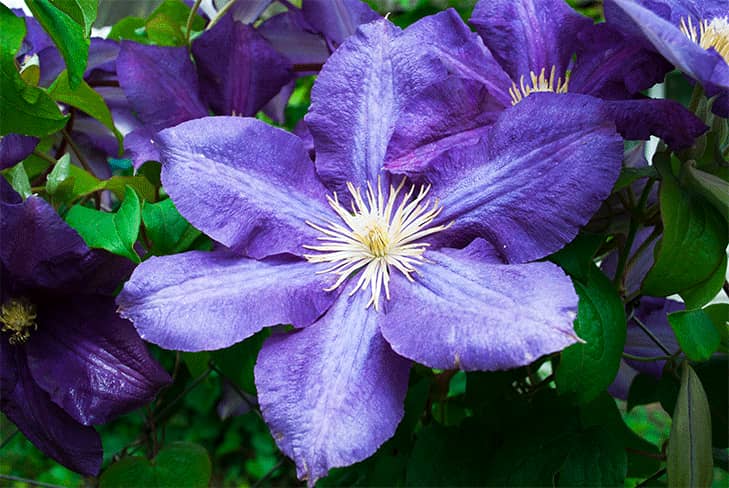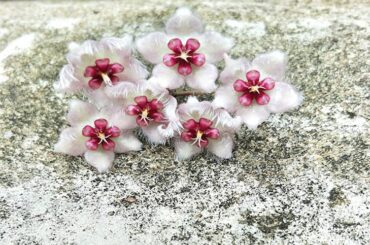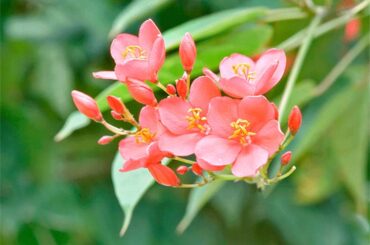Clematis Jackmanii Superba is entitled to the title -“The queen of flowering vines”. Want to incorporate some delicate nuances to the harsh edges of your surroundings? Choose to grow some Clematis Jackmanii. Clematis Jackmanii Superba is sophisticated flowering vines; these vines come with vibrant purple flowers and create gorgeous curlicues over archways, fences, mailboxes, etc. Their lissome vine structures stand out while the eldritch shades of purple-colored flowers make a dazzling contrast with the green anthers. These vines are quite popular among gardeners owing to their eclectic color combinations and tolerance levels; these climbers are invincible when it comes to their flowering presences. These ravishing vines belong to the Ranunculaceae family and have a versatile collection of 300 species and 100 gorgeous hybrids.
What is Clematis Jackmanii Superba
Clematis Jackmanii Superba , a dazzling flowering vine that accentuates the overall beauty of its surroundings. Its luscious, dazzling violet purple-colored flowers soften harsh edges like posts, fences, and walls. These varieties grow to a length of 2-3 m and their iridescent appearances make a lasting impression. They need very little care but their boons of beauty are quite rewarding and eye-soothing. Jackmanii Superba is considered to be a refined version of the long-time garden favorite Clematis Jackmanii.
Characteristics of Clematis Jackmanii Superba
- These vines come usually grow up to a height of 3-3.6m and their width is around 50cm. It adheres well to the cool to temperate temperature zones and can adapt meticulously in areas having full to partial sunlight exposure.
- The plethora of flowers is seen from mid-June to August. These flowers are deep purple in color and add luminosity to the overall look of Clematis Jackmanii Superba.
- It’s quite effortless to train Clematis Jackmanii Superba around trellises or obstacles.
- On an eldritch, cloudy day, the flowers would look almost black.
- These plants are highly tolerant of urban pollution so these plants can garnish the urban locations quite well.
Rudimentary Insights:
| Botanical Name | Clematis x Jackmanii |
| Common Names: | Clematis Jackmanii, Jackman Virgin’s Bower, Jackman’s Clematis
|
| Plant type: | Deciduous trees |
| Mature size: | 7-10 feet tall |
| Sun Exposure: | Partial to full sun |
| Soil type: | Well-drained |
| Soil pH | Neutral |
| Bloom time | Late spring to Autumn |
| Flower color | Violet purple |
| Habit: | Climbing vines |
| Higher Classification: | Leather flower |
| Habitat | Northeast Part of America and Australia. |
| Zones | 4-11 |
Differences between clematis Jackmanii and Jackmanii Superba
As the name Clematis Jackmanii Superba suggests, it’s the superior version of Clematis Jackmanii. It’s the more improved version of Clematis Jackmanii. Moreover, it has more magnificent blooms and more vines. Clematis Jackmanii Superbais the better and sturdier version of Jackmanii Superba.
Advantages of Clematis Jackmanii Superba
The list of the advantages of Clematis Jackmanii Superba is pretty long. Here are some of them
- These plants come in all sizes and hues of purple shades. These flowering vines are popular among gardeners as there are not many precautions that need to be followed prior to growing Clematis Jackmanii Superba.
- Moreover, these plants create a spectacular ambiance due to their delicate features.
- Clematis Jackmanii Superba plants are also well known for their flexibility.
Disadvantages of Clematis Jackmanii Superba
The main disadvantages of Clematis are as follows:
- It can be a bit tricky to find the right place to grow them; these plants prefer to keep their headsout in the sunlight while their roots need to be placed in shaded, cool areas.
- Although these flowering vines are quite flexible, their stems can be broken quite easily. So one has to follow some precautions while planting them.
- Clematis Jackmanii can’t be grown without supporting structures like other plants or solid objects. These usually wrap themselves around solid objects or other plants and don’t have the ability to grow on their own.
Required types of equipment or Kits to grow Clematis Jackmanii Superba
- Seed trays
- Horticultural Disinfectant
- Sterilized seeding plant mix
- Clean terracotta containers.
- Water
Select equipment which are in top-notch conditions; such selection would be handy to simplify the overall process of rearing the plants properly. Sterilized equipment is a must to keep the risks of infestations at bay. Proper hygiene and cleanliness are the most important facets here.
Understand pH Condition
There are many innuendos about how the pH level of the soil can impact the overall growth of the flowering vines. Clematis Jackmanii Superba grows majestically when it’s planted in soil having a pH value of 7. The reason behind this is that if the soil is neutral then the absorption of nutrients like Magnesium, Nitrogen, and Potassium, etc. ensues smoothly whereas an acidic or alkaline pH value disrupts the total absorption process and thus the growth of the Clematis Jackmanii Superba plants fall prey to various obstacles.
| Soil pH level | Adherence Capability |
| Below 7 | Grows on an average level |
| 7 | Grows in a magnificent way, the ideal pH value is 7 |
| Above 7 | Grows moderately |
What type of soil is best for Clematis Jackmanii Superba
Clematis Jackmanii Superba adheres well to well-drained soil; one of the important facets of growing Clematis Jackmanii Superba is to keep its roots evenly moist. If you grow Clematis Jackmanii Superba in a container then a drainage hole should be created at the bottom of the container. And also soil with a neutral pH value of 7 is highly commendable for making the Clematis Jackmanii Superba plants bloom to their fully-fledged form. However, these flowering vines absolutely detest poor, clay or sand-like soils.
Soil Prepare with Organic Fertilizer
The pros of organic fertilizer are that it helps to loosen the clay particles and also helps the sand to hold more water. Adding organic fertilizer to the soil would enhance the overall growth of the Clematis Jackmanii Superba plants. Work some compost into the soil along with some other organic additives like plant particles, manure, sawdust, and green manure. Never use fresh manure.
| Organic Additives | Details |
| Green Manure | Prepare green manure with rye and oats during the fall and spring. |
| Gypsum | Add about 3 to 4 pounds of gypsum per hundred square feet. |
| Compost | Compost consists of decayed plant materials. |
How to Grow Clematis Jackmanii Superba
There are two well-known tactics of growing Clematis Jackmanii Superba; (i) Planting them directly outdoors (ii) Planting them in containers.
Planting them directly outdoors
- Clematis Jackmanii Superba can adorn your garden by creating beautiful layers around your other plants like hydrangea, lilac, etc. Here are some tips apropos growing these spectacular plants in your garden.
- Choose an ideal location or area to plant your Clematis Jackmanii Superba plant. You can opt for an area surrounded by perennials and also with a good level of sun exposure. The perennials would provide shade to the roots while the sun would enhance the growth of the flowering vines
- If you are planning to plant the vines in your garden, first select a support structure for the Clematis Jackmanii Superba. You can choose other plants like hydrangea, lilac, hazels as the support structures you can choose inanimate objects like fences, walls.
- Dig a hole having an area of about 24 X 24sq. inches; this would give the plants enough space to spread around.
- Water the planting hole so that a moist environment is prepared for the new plant beforehand.
- Fill the soil with organic compost; the organic compost is made of peat moss, perlite, and vermiculite. After filling the hole with enough organic compost, spread it towards the shrubs growing nearby. Clematis Jackmanii Superba plants are a bit finicky about placing their roots so it’s better to make more space for them.
- Add a bit of fertilizer and then place the Clematis Jackmanii Superba plants in the hole. Add depth by adding more compost.
- Now your plants are all set to sprout and prop against the other plants within 2 to 3 years.
Growing Clematis Jackmanii Superba in containers
- First, choose a terracotta container; make a drainage hole at the bottom to facilitate a well drainage system. The depth and width of the container should be around 18-45 inches.
- Fill the container with pebbles; this would make the container feel like a home to the new plants.
- Place the plants in a bucket of water before placing them in the terracotta container. This ensures a good moisture level.
- Fill the terracotta container or pot with ample compost mulch; this is a very crucial step.
- Select a support structure; incorporating the support structure in the container would enable the tendrils of the vine to clamber on smoothly.
- Place the water dripped Clematis Jackmanii Superba in the container and keep adding more mulch to the container.
- Don’t forget to incorporate fertilizers before the arrival of the blooming period.
- Keep mulch 8 inches away from the base of the stems in order to prevent untimely wilting.
Growing Clematis Jackmanii Superba from Sow Seeds
- It requires a bit of patience to witness the growth of Clematis Jackmanii Superba straight out of seeds.
- Seed selection must be done diligently; trays must be kept ready with mulch and compost.
- It’s a commendable tactic to add rooting mixtures or powder to the compost.
- Fill the tray with brimming water and then sow the seeds there.
- Once the sowing part is done, you must watch out for the signs of germination.
- Place the tray in a shaded environment where a fair amount of sunlight can be accessed as well. It takes around 12-36 months for the seeds to germinate.
- When the shoot begins to sprout, that’s the sign of the ongoing germination of the seeds. Place the germinated saplings outdoors and plant them cautiously.
Clematis Jackmanii planting depth
Plant the plants about 3 to 5 inches below the surface of the dirt. This is the ideal depth for planting Clematis Jackmanii Superba plants. This facilitates the spread of the plants while they grow up. Planting at this level promotes the development of the latent buds.
Propagation of Clematis Jackmanii Superba Plants
Propagations of Clematis Jackmanii Superba plants can be done in numerous ways; propagation by cuttings and propagation by layering are two of the most preferable ways of propagation of Clematis Jackmanii Superba plants.
Propagation of Clematis Jackmanii Superba plants through cutting
Choose a sharp pair of scissors or knife to cut off the leaves from the Clematis Jackmanii Superba plants; take a cutting of about 14 cm and remove the residual leaves at the bottom. Dip the ends into a suitable rooting solution and place the leaves in a suitable pot. Prepare the pot with sufficient compost beforehand.
Propagation of Clematis Jackmanii Superba Plants Through Layering
Choose a stem long enough to be splayed on the ground; gently bury a length of the stem deep in the ground and moor the buried portion with some stones and rocks. Eventually, new plants will sprout from that layer and you can detach that buried portion from the parent plant. It takes a year, approximately, to propagate Clematis Jackmanii through layering.
When Do I Start Pruning Clematis Jackmanii Superba
Clematis Jackmanii Superba belongs to the third group of Clematis; the vines can clamber to a great height and it needs pruning around the time between late winter and early spring. If pruning is not done accordingly, then the tendrils along with the blooms would reach too high and it would be hard to get a good look at those beautiful flowers. Pruning should be done within 6 inches of the ground. Cut back the tendrils 1 to 2 feet every few years to reignite the blooms of the plant. On top of that, if signs of wilting are seen, then prune the affected stem 1 inch below the debilitated \area. Do not neglect while taking these peremptory steps.
How To Make Clematis Jackmanii Superba Bloom?
The appealing features of Clematis Jackmanii Superba mainly revolve around its scintillating purple flowers. Clematis JackmaniiSuperba mainly blooms on new wood. One should be very careful before applying fertilizer to the Clematis Jackmanii Superba plants; applying fertilizer during the blooming period would be detrimental to the upcoming flowers. The blooms wouldn’t last that long if fertilizer is applied during the blooming period. Clematis Jackmanii Superba’s blooming period mainly starts from late spring and continues till the early fall. The blooming period comprises the months’ May, June, July, August, September, and October.
Maintenance and Care For Clematis Jackmanii Superba:
The plants require lower degrees of maintenance compared to the other plants. Nevertheless, these plants must be nourished with enough nutritious condiments. Their overall growth can be fueled by proper care and maintenance. Clematis Jackmanii Superba plants grow into their fully-fledged forms when they are dealt with sufficient attention and care. Here are some of the ways you can keep an eye out on them while they bloom at their own paces. Following these rudimentary steps can result in quite riveting results.
- Keeping the moisture levels in check: Clematis Jackmanii Superba favors uniform levels of humidity. It is susceptible towards growing in soil having uniform moisture levels. When the soil gets too patchy, the foremost thing that needs to be done is to ensure that the plants get watered deeply. Or else the plants will be lacking in nourishment and would fall prey to diseases like wilting. In order to balance the moisture levels, spread a 2-inch thick layer of organic mulch around the roots; this keeps the roots moist and cool. Leave a 2-inch gap between the base of the plant and the mulch layer to get rid of the excess moisture. Replace this mulch each spring.
- Watering the plants: Keep the Clematis Jackmanii Superba well-watered- These vines thrive well in moist yet well-drained soil conditions. Treat them to long gulps of water whenever the soil seems dry or patchy. It’s recommended to water it in the morning rather than the evening; the water than gets absorbed easily before the night falls.
- Fertilizing Clematis Jackmanii Superba Timely: Fertilize the vines generously after every 4 to 6 weeks; feed them with 10-10-10 NKP fertilizer; you can also mitigate their avaricious hunger by providing a side dressing of compost or mulch around the base. But refrain from fertilizing the plants during the blooming period. Work the fertilizer into the top 2 inches of soil with ardent care. It’s advisable to fertilize generously from April to August.
- Support System: Adjust the support structure from time to time: As mentioned before, these vines twist around some supportive structures. As they clamber towards greater heights, new forms of supports are needed for their vines to wrap around. However, the support systems should be less than 5 inches wide in diameter.
- Sunlight and Temperature: As discussed before, these dazzling flowering vines are great proponents of full to partial sunlight while they like to keep their roots shaded. Clematis Jackmanii Superba loves to grow in the midst of other perennials; their roots are protected from scorching rays due to the shade offered by the surrounding perennials.
- Pest Control: Use a moderate amount of pesticides to keep the infestations at bay. However, it’s preferable to switch to organic measures like spreading diatomaceous earth around the base of the stems. Doing so keeps the slugs’ pest infestations away.
Frequently asked questions (FAQs)
Question : When does clematis Jackmanii bloom?
Answer: Its blooming period mainly starts in the summer and lasts till the fall.
Question : How big does the Clematis Jackmanii Superba grow?
Answer: Superba grows about 3 to 7 feet tall and it’s 3-6 feet wide.
Question : Does Clematis Jackmanii Superba grow as bulbs?
Answer: No, they don’t grow as bulbs.
Question : Is Clematis Jackmanii Superba toxic?
Answer: Yes, they are highly toxic and should not be ingested at any cost.
Question : Is Clematis Jackmanii Superba evergreen?
Answer: No, they are deciduous flowering vines.
Question : What does Clematis Jackmanii leave look like?
Answer: Their leaves are oppositely pinnate compounds. The leaflets have a length of 2-4 inches.
Question : What is the best time for transplanting Clematis Jackmanii?
Answer: It’s best to transplant during the late winter or early spring i.e. September or early October.
Question : How long does clematis bloom?
Answer: They bloom during the month’s May to October.
Question : Do deer eat clematis?
Answer: If the deer don’t find any other plants in the vicinity, they would then settle for eating Clematis Jackmanii Superba.
Question : What are the best companion plants for Clematis in pots?
Answer: Ajuga, hardy geraniums, hazels, sweet woodruffs, Siberian iris are the best companion plants for Clematis Jackmanii Superba in pots.
Question : What is the Clematis temperature tolerance?
Answer: It can tolerate sunlight for 6 hours straight; they are found in the heat zones 1-9. They adjust well in partial to full sunlight.
Final Thoughts
Clematis Jackmanii Superba plants are terrific forms of adornments for your garden; these can usher in delicate layers of exotic beauty right to your doorsteps. Their incandescent blooms can rejuvenate your mind and all you need to do is be a little aware of their growth and requirements. The quintessential thing to remember while growing these vibrant vines is that you should provide adequate support to the plants or else the vines won’t be able to clamber to greater heights. Follow the guidelines given above and you would be rewarded with some invigorating shades of Clematis Jackmanii Superba. Inculcate some Clematis Jackmanii Superba in your garden today and you will never regret it.





